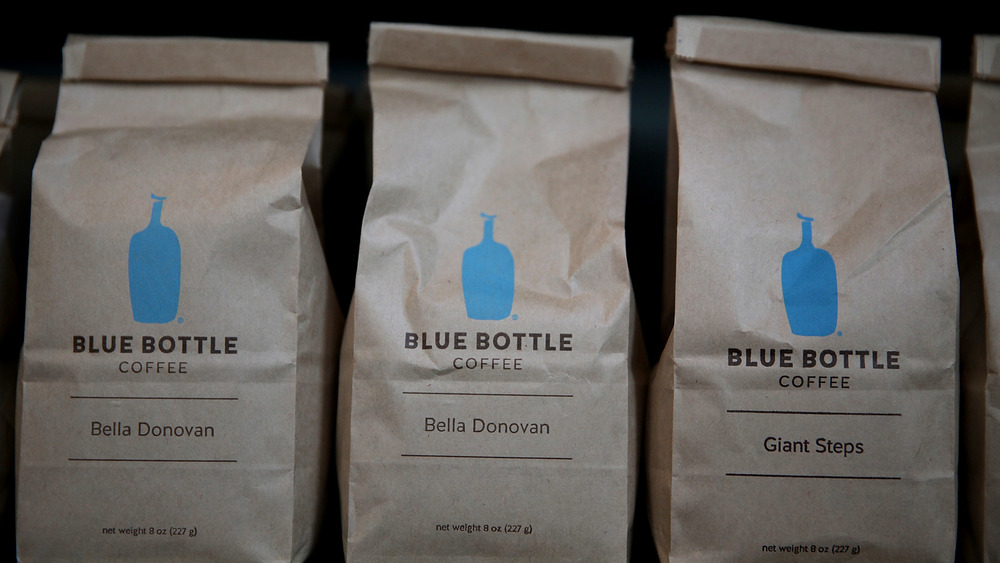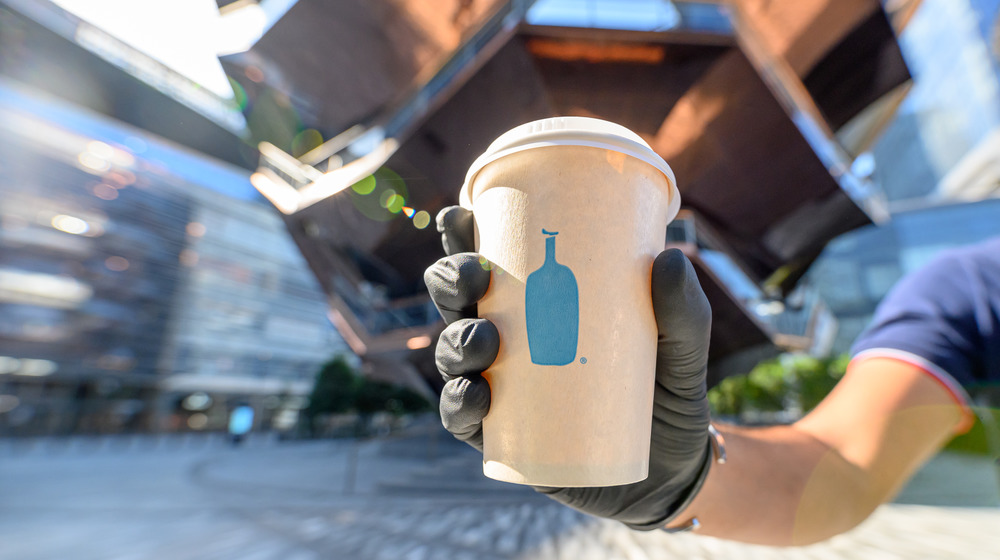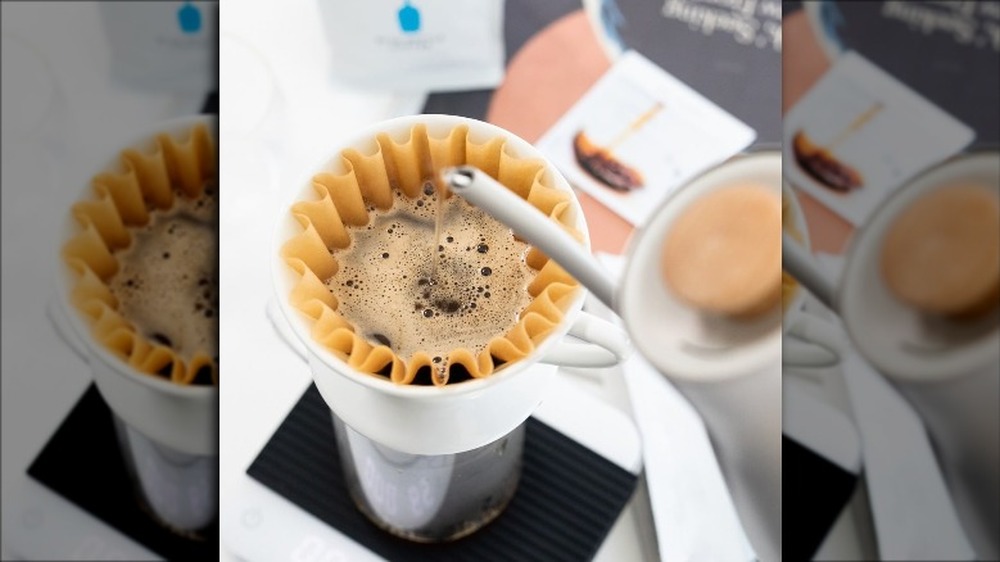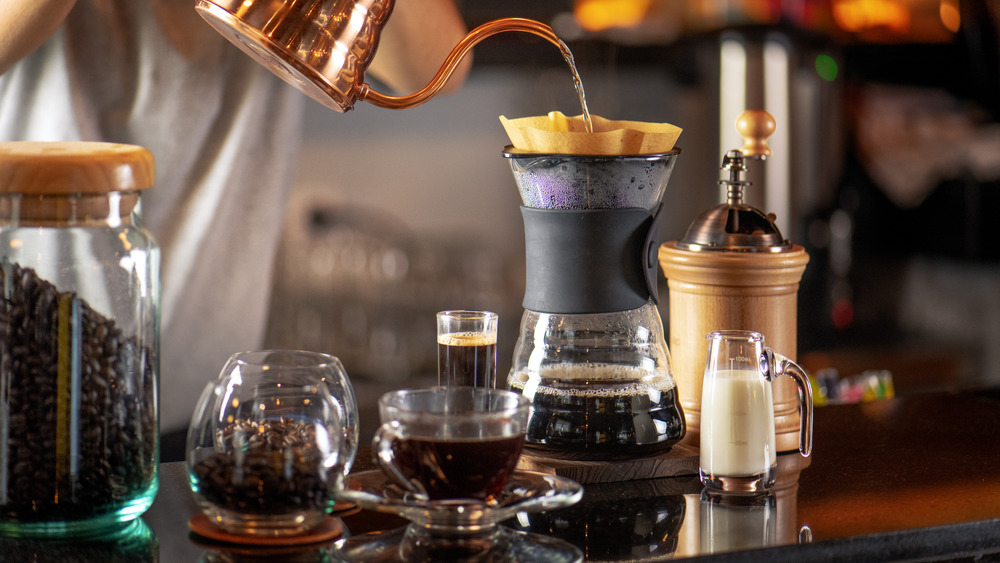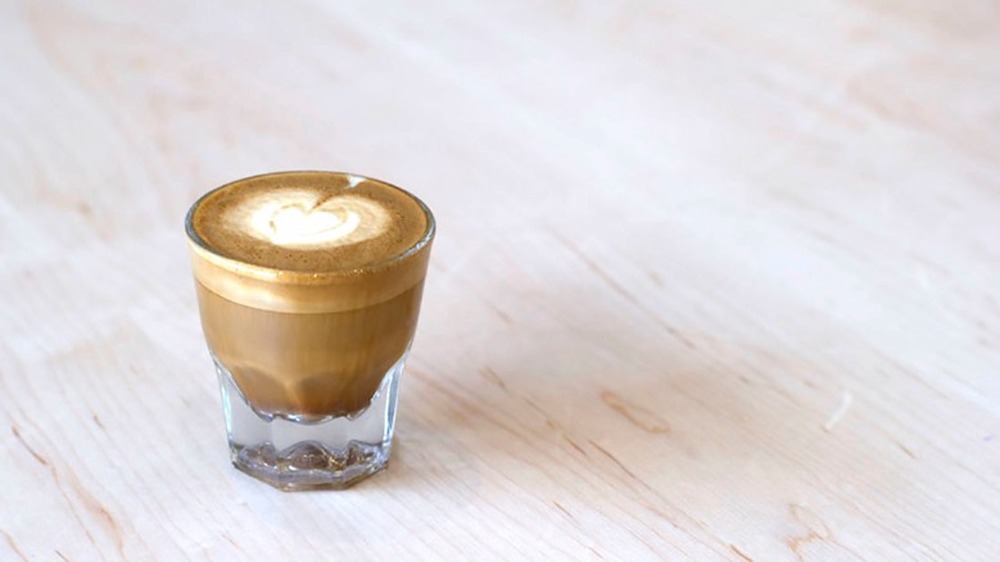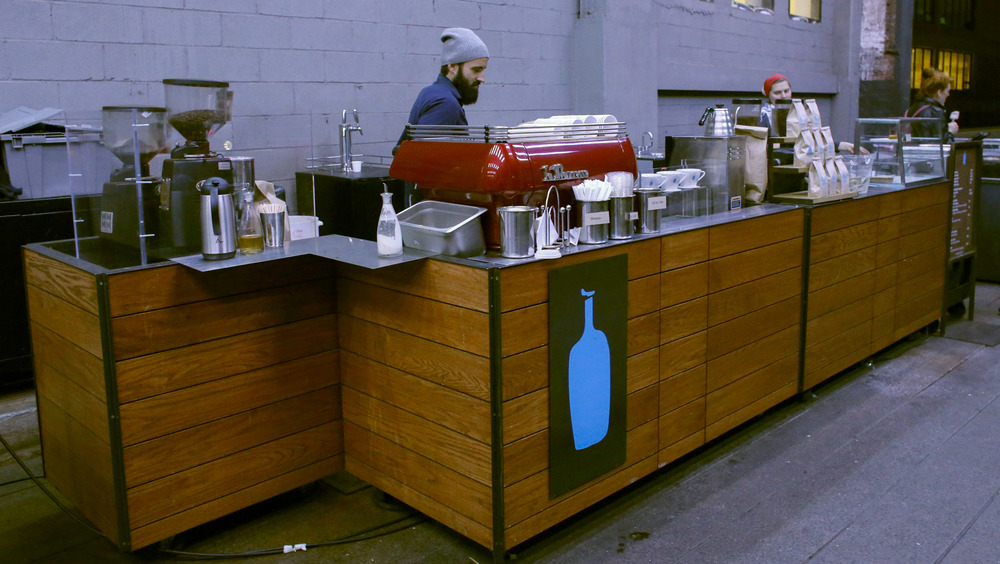The Untold Truth Of Blue Bottle Coffee
If you live in the Bay Area, there's no way to escape Blue Bottle Coffee. The company got its start at a Berkeley farmers market in the early 2000s, but it was the network of cafes in San Francisco that spawned a cult following, allowing the brand to spread to New York, Boston, Washington D.C., and eventually to Japan, South Korea, and Hong Kong, as well. According to CNBC, a number of big name investors pitched in to help Blue Bottle rise to fame — people like Instagram founder Kevin Systrom and U2's Bono — which helped to elevate the brand from humble Bay Area roasters to pioneers of the third-wave coffee movement.
Was it simply Bono's magic touch that gave Blue Bottle Coffee the shot of espresso it needed to take over the world? Or was there a different kind of magic at work in the original farmers market stand, or the first Blue Bottle cafe; which, according to the founder, was located at the end of a "pee-smelling, dead-end alleyway." If someone sees fit to charge $16 (via Inc.) for a cup of coffee served in an alley that smells like urine, do we burn him at the stake, or elect him as president? Let's find out more before we decide.
History matters at Blue Bottle Coffee
The eponymous hand-drawn, sky-blue bottle that serves as Blue Bottle Coffee's logo is filled to the brim with powerful origin stories. Sit back and relax, perhaps with a cup of cold brew, as we tell you how this company got its name, its start, and its gumption for charging so much for bean water.
According to the Blue Bottle Coffee website, when the Turks were driven out of Vienna in the 17th century, they left bags of mystery beans, thought to be camel food, behind. A celebrated emissary of the Viennese government, named Franz George Kolshitsky, recognized them as coffee beans and used them, along with money gifted to him by the mayor, to bring Turkish coffee to Vienna. He opened The Blue Bottle, the first cafe in Central Europe. Fast forward three centuries, and founder James Freeman — embarking upon his mission to bring freshly roasted coffee to the people of Oakland, California — named his coffee after this historically momentous (for coffee) event.
Blue Bottle Coffee is very particular about its beans and beverages
Freeman himself was a freelance musician before he was an industry-disrupting coffee lord and, in fairness, it probably took a lot of moxie in 2001 to imagine that roasting coffee beans might be more lucrative than playing the clarinet. But imagine he did, according to CNBC, and he even rented a 186-square-foot potting shed (for $600 a month, yikes) to put his money where his mouth was.
Freeman's vision was to sell fresh roasted coffee beans — no more than 48 hours old — to local coffee lovers who might find giants like Starbucks and Dunkin' a bit lacking. So, in his tiny shed, Freeman fired up the roaster, cooked the beans seven pounds at a time, and then hand delivered them in brown bags (stamped with the blue bottle) around the area in his station wagon (via Blue Bottle). To this day, when Blue Bottle expands into new cities, it invests in building local roasteries, so that its cafes are never too far from the source.
Blue Bottle Coffee is innovative when it comes to products and its work environment
Even at five bucks a cup o' joe, every coffee company knows that in order to be successful, you can't just serve coffee. Thrillist points out that in addition to coloring books, $150 pajamas, and Cascara Fizzes (which are fancy-schmancy sodas made out of tea from coffee cherry husks and lemon...obviously), Blue Bottle partnered with Drake's brewing company to make its own stout.
Some innovations occurred completely by accident, of course. On the company blog, a few employees share that the platform baristas stand on when pouring coffee was actually a happy accident. Explains Freeman: "The baristas at the Kiosk are elevated on a platform because I forgot the castors on the coffee cart were going to be six inches, so...we cobbled together a platform at the last minute, then, all of a sudden, you're elevated — you're put on a pedestal in a literal sense." Baristas still use the platform today, and love how much control the visual advantage gives them.
Blue Bottle Coffee has a secret menu
Blue Bottle is innovative in the kitchen, too, and some of those same happy accidents and inventions have led to more than a few secret menu items. For example, according to Thrillist, you might want to try asking for a "Waffogato" at the Ferry Building location. A Belgian waffle with a scoop of vanilla ice cream, a sprinkle of sugar, and its house espresso poured over the top? Yummy.
One not-so-secret off-menu item is Blue Bottle's "Gibraltar" — a tiny, strong latte in a small glass tumbler. According to the company website, someone accidentally ordered an abundance of short, octagonal glasses, called Gibraltars, back in the early days of the original location. Too small for coffees and too big for espressos, baristas began using the glasses to measure and test its espresso shots. Eventually, someone added a bit of steamed milk over the top of a two-ounce pour, and voilà! A magic mini-latte was born. Of course, it's the same drink that goes by the name "cortado" at any other coffee shop, but at Blue Bottle, it's a Gibraltar, and it's got a history.
Blue Bottle Coffee makes it easy for hipsters to feel right at home
Hipsters look for certain signals before they pick a coffee shop in which to enjoy their espresso. Wide brimmed hats are helpful, perhaps some oat milk in the vintage cooler by the register. Fair trade coffee is a must, obviously, and vegan pastries are a pleasant perk. They must feel right at home in a Blue Bottle, therefore, because in addition to ethically-sourced beans, the aesthetic of a Blue Bottle cafe is relentlessly hip.
According to Thrillist, Blue Bottle's Oakland headquarters even employs a resident apiarist, who keeps bees on the roof of the building so the team can make their own honey...which might be the most hipster thing we've ever heard.
Business Insider went to Williamsburg, Brooklyn to visit Blue Bottle Coffee, when it opened there in 2015. Inside the cool, 20th-century brick building (formerly a glass blower's, a barrel maker's, and a metal smith's) was a menu of items to tickle a hipster's fancy. A vintage Probat roaster guaranteed that famous 48-hour freshness, while a collection of Japanese slow, cold-drip coffee makers were on hand to make Blue Bottle's Kyoto iced coffee. Perhaps the hippest of the features is a restored lever espresso machine, called a Faema Urania. Whether they chose it for its features or its name, a veiled reference to that first, urine-smelling Blue Bottle location, remains another exciting mystery in the extensive Blue Bottle mythology.
